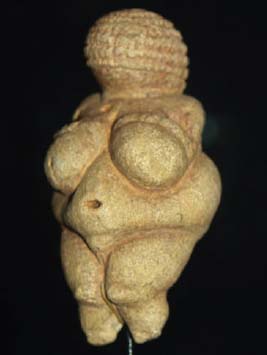Art Principles and HistoryPrehistoric Art |
What is the Venus of Willendorf? |
Also referred to as simply the “Woman of Willendorf” this prehistoric “Venus” is a small sculpture (an example of mobiliary art) discovered in Willendorf, Austria, and was made in approximately 22,000 B.C.E. Found in 1908, its given name is ironic. Venus, the goddess of love and beauty, is usually depicted as thin, graceful, and lovely. The Venus of Willendorf, by contrast, is short (less than five inches high) and obese. She has no discernible face, only what seems to be a pattern of braided hair. Her sexuality and fertility is emphasized through an exaggeration of her female features while other figurative elements have been minimized; her arms are very small and her legs taper dramatically. The work’s small size and defined features suggest it was designed to be held and touched. Debate continues as to whether the sculpture depicts a real person, or is a symbol for fertility and health. It would seemingly be difficult to achieve such a body type during the lean years of the ice age. The Venus of Willendorf’s obesity, while playfully mocked in the early twentieth century by those who discovered her, was likely highly valued as an omen of prehistoric health and survival at the time of its creation. Hundreds of similar sculptures have been found.

The Venus of Willendorf is a prehistoric sculpture carved from limestone. The artist emphasized the physicality of the female form, and the object was perhaps used as a fertility idol.
